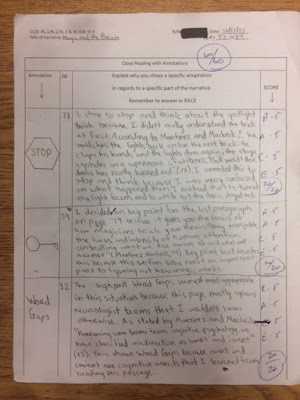Interacting with the Text
 |
| Posters I use while we interact and annotate various text. |
Many people today identify themselves as "hands on learners". This is really great, we learn by doing and interacting with tools so we can complete a task. Remember when smartphones hit the scene. The only way we learned how to use those sometimes pesky devices was by interacting with them,and pressing all the right and sometimes wrong buttons. So how do we get students to press all the right buttons while reading a text? How do we get students interacting with fiction and informational text we read in class ? I would like to suggest using various annotations/cognitive markers. A few examples are Notice & Note Signposts, Depth and Complexity Thinking Prompts, and annotations,
you or students can create.
you or students can create.
INCORPORATING ANNOTATIONS, ALSO CALLED COGNITIVE MARKERS, WHILE READING A TEXT WITH STUDENTS, WILL PROVOKE REFLECTING, RESPONDING, AND THINKING.
I'm the type of teacher who likes to implement new things. When something doesn't work, I file it away to try again later, but when something does work I invest some energy into it and incorporate it into my teacher toolbox.
After reading the books Notice & Note and Reading Non-Fiction, I made some charts (pictured above), and I got to work. Tired of my same ol' boring way of reading with the class I passed out a simple T-Chart, and told the students to grab their favorite writing utensil along with our reading material and it happened. We started interacting with the text. As we read we stopped and used "noticed and note" signpost strategies on one side of our T-Chart. On the other side we reflected on, commented or discussed our annotations relating to what we noticed in the text. From the first day of implementing this notice and note strategy, I could affirmatively we have used many different styles of thinking maps, t-charts, and teacher created activities while reading, interacting, and annotating various text. The students do not get bored and the novelty of this activity stays relatively high because you and the students can create signpost, or symbols, for specified text.
After reading the books Notice & Note and Reading Non-Fiction, I made some charts (pictured above), and I got to work. Tired of my same ol' boring way of reading with the class I passed out a simple T-Chart, and told the students to grab their favorite writing utensil along with our reading material and it happened. We started interacting with the text. As we read we stopped and used "noticed and note" signpost strategies on one side of our T-Chart. On the other side we reflected on, commented or discussed our annotations relating to what we noticed in the text. From the first day of implementing this notice and note strategy, I could affirmatively we have used many different styles of thinking maps, t-charts, and teacher created activities while reading, interacting, and annotating various text. The students do not get bored and the novelty of this activity stays relatively high because you and the students can create signpost, or symbols, for specified text.
THESE BOOKS ARE GREAT RESOURCES,TO GUIDE YOU INTO YOUR FIRST STEP TOWARD LEARNING HOW TO TEACH STUDENTS TO INTERACT AND ANNOTATE A TEXT.
(you may also find yourself interacting and annotating texts when you read on your personal time) :)
(you may also find yourself interacting and annotating texts when you read on your personal time) :)
I highly encourage you to take some time and learn how you can implement annotations, and notice and note reading strategies into your ELA time. Once you learn the process of interacting with the text, there is little prep involved, and there is a big payoff because students will surprise you with how many "signpost", they notice while reading!






No comments:
Post a Comment